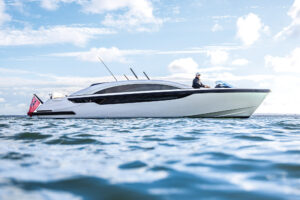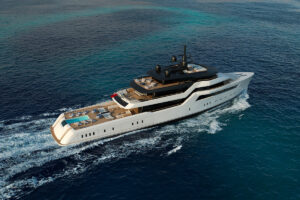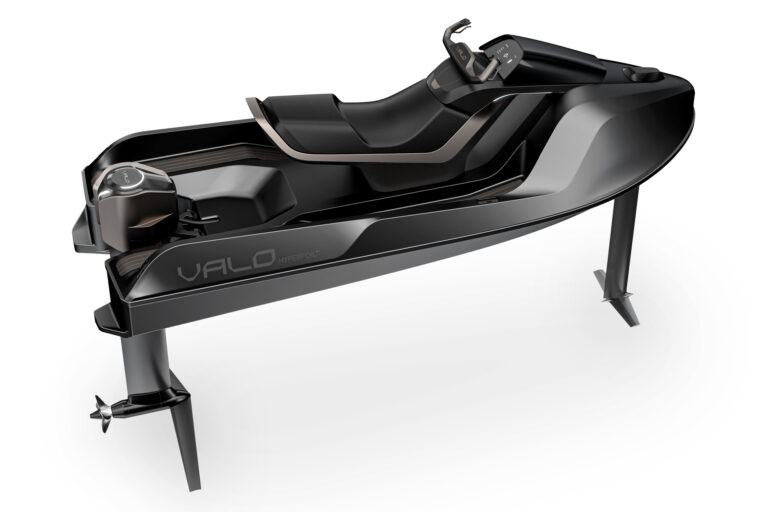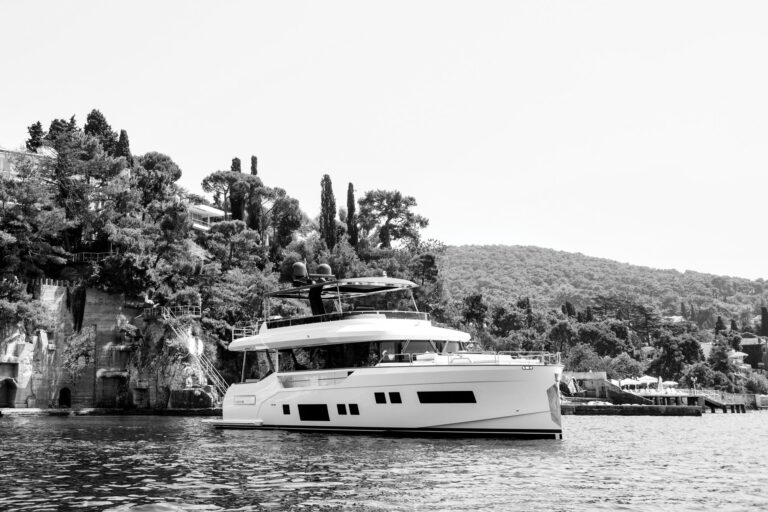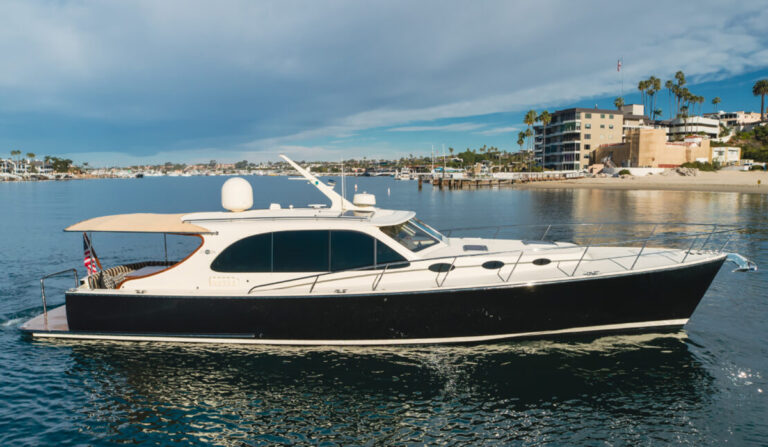Through the years Sea Ray‘s Sundancer line couldn’t help but influence the direction of the American express cruiser market. The builder has committed more than a catchy nameplate to maintaining this lofty perch: Sea Ray listens to its customers and gives its design team the tools and the autonomy it needs to translate feedback into reality.
Thus it is no surprise that the distinctive new 48 Sundancer is another excellent return on this philosophy of investing in the future. After all, when a builder produces as many new designs as Sea Ray does, it sometimes pays to look at things in a different way. This has been Sea Ray‘s modus operandi as it has complemented an already formidable design department with new talent from outside the marine industry. Much of this creative juice has been tapped from the auto world, and first showed up in marketing; for instance, in Sea Ray‘s drive to improve customer service. The 48 is the first new boat design to reflect this creative crossover.
If you are a fan of the marque, the first thing that may draw your attention is the new design’s badge-“48” not “480.” It is the only boat currently in the line with this new, simplified designation. It has been years since Sea Ray helped inspire the trend in the added-0 style of branding so the change seems timely. You may have also noticed that Sea Ray‘s Web site has been remodeled to have the look and feel of an automotive site.
These subtleties in delivery pale however, when you consider that the 48 features a semi-enclosed helm design-a first in the Sundancer line. According to Sea Ray, the one thing its owners have always shared is distaste for fussing with isinglass and canvas. Recognizing that most folks use boats in this class with canvas tops in place, Sea Ray made fiberglass hardtops a standard feature on many of its designs several years ago. Completing the enclosure with glass seems a natural progression.
The inclusion of full glazing required a new approach to Sea Ray‘s windscreen design; here too the result is quite pleasing. The curved face is divided by a center support and meets the side sections at powder-coated aluminum pilasters. The rakish window line plays a significant role in the 48’s profile and I suspect that it is a styling cue that will be repeated on other Sea Ray designs in the future. The fiberglass hardtop arches forward and is capped by a forward-raking mini-arch that serves as a platform for the radar.
The 48’s sweeping sheer drops almost to the water aft, extending what seems to be the popular trend of blurring the distinction between superstructure and hullside. The sheerline feathers into a platform-lift that can accommodate a small tender or a personal watercraft. The 48’s hull-side windows are not a first for Sea Ray and they follow an ongoing effort by the builder to bring more natural light aboard. Our test boat’s “pewter” gelcoat finish is new and should please those not bound by tradition (white).
One of the greatest challenges in a semi-enclosed helm design is keeping things cool undercover. Sea Ray‘s solution includes an electrically actuated windscreen vent and two center-hinged skylights in the hardtop that can be opened fore and aft. The optional 24,000 BTU helm air-conditioning system and the generator upgrade to power it are a must if you intend to cruise warmer climes. It would also be nice to incorporate shades on the overhead skylights (Sea Ray is working on it).
The bridge and cockpit layout benefit from the new thinking at Sea Ray as well as a bit of trickle-down from the larger boats in the line. The adjustable helm and companion seating can pivot 90 degrees as a unit (away from the helm). This, together with seating to port, creates a helm-level lounge area. The dash has enough space for the usual electronics as well as two daylight-viewable 12.1-inch touch-screen displays that accompany the Sea Ray Navigator II system. This clever PC-based system includes radar, plotter and more in a single intuitive package that is virtually foolproof.
Teak steps lead below to the main cabin. An L-shaped settee faces a high-low table and an entertainment center with a 23-inch flat-screen TV. The galley area has a cook-top and a microwave-convection oven (a hardwood sole is optional). The forward stateroom’s island berth has an innerspring mattress and separate head and shower compartments. A mid-stateroom with a head is positioned aft of the companionway. A slide system allows the two single berths to be arranged as a queen if desired. Those who opt for the washer/dryer will sacrifice the mid-stateroom hanging locker.
While the 48’s interior has a look and feel that will be familiar to Sea Ray owners, there are subtle changes that I believe are for the better. Counter space and seating are designed to look good and be user-friendly. In simple terms, there are fewer curves. As an example, the forward berth is not some sleep-defying irregular shape, but looks and works like a bed. In the main cabin you can lie down on the straight sections of the settee without having to curl up. These are the sorts of details that you’ll appreciate when you spend more than an afternoon aboard. The look is also more sophisticated with fewer areas finished with soft goods; cherry hardwood trim and veneer are favored.
Sea Ray builds the 48 at its Palm Coast, Florida, facility. Hulls and superstructures are molded with a blend of stitched and woven reinforcements and polyester resin. A network of fiberglass stringers and plywood bulkheads supports the hull. A variety of core materials are used to stiffen areas of the superstructure and decks. The machinery space is accessible from a hatch in the cockpit and service points appear accessible.
I conducted sea trials on the Intracoastal Waterway aboard a 48 fitted with a pair of 540-metric hp Cummins. The 48 is responsive, trims nicely at speed and while there was little more than a ripple on the water during testing, I suspect she will be dry in a seaway. For a boat of her size and speed, her 19-degree transom deadrise should provide a comfortable ride offshore. She reached a maximum speed of 30.9 knots in a little over 20 seconds and her SmartCraft engine electronics indicated a fuel burn of 32.6 gallons-per-hour at 21.4 knots (2100 rpm).
The 48 is an important new boat for Sea Ray and her semi-enclosed helm design is a milestone in the Sundancer line’s evolution. She is also significant as she reflects the vision of a diverse and talented team of creative folks that answers to an industry leader who is not afraid to think outside of the box.
Contact: Sea Ray Boats, 800-SRBOATS; www.searay.com.

